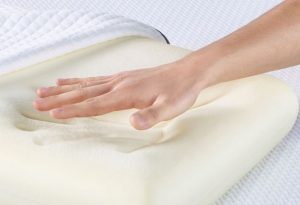Sheet Material
At any one time, we can stock up to 70 blocks of foam on site, but if we do not have the foam you require, we can have it delivered to us within 2 working days.
The blocks can be cut down into sheets of material, giving you the flexibility to cut and shape the foam yourself, or, alternatively, we can cut and shape the sheet material for you. We have automatic slitting machines which can supply large quantities of material at a given thickness, or we can produce sheets at any required thickness and size, using CNC machines. Either method produces sheet material cut to very close tolerances.
The potential use of sheet material is extensive, typical examples are headboards, cushions, seating, packaging, mattresses, mattress toppers and layering in upholstery and bedding.
Range of materials
Ether Range of foams
The majority of the foam that we use falls into the Ether range of foam types. The Ether range is further divided into Combustion Modified (fire retardant), or, Non – Combustion Modified (non fire retardant – suitable for use as packaging or solutions where fire retardant properties are not a requirement). The range of foam densities that we can provide within these categories is wide. If you are not sure about the foam type that you require for a particular purpose, do not hesitate to contact us and we will be happy to offer our assistance.
Combustion Modified Ether Range
Filler Free Combustion Modified Ether Range
Combustion Modified Ether Range (Memory Foam)
Combustion Modified High Resilience Range
Standard Grade, Non – Combustion Modified Ether Range
High Load Bearing, Non – Combustion Modified Ether Range
Combustion Modified Reconstituted Foam Grades
Reconstituted foam (Combustion Modified Reconstituted Foam (Recon))
Reconstituted foam (or Recon as it is known) is manufactured using foam which is left over from our day to day operations. The foam is returned to the manufacturer who chips the foam, adds a flame retardant additive and glues the pieces together. The mixture of foam and glue is then compressed under differing pressures which results in the differing ‘weights’ of recon blocks. Typical uses of recon are heavy duty seating, gym mats, packaging and sound insulation / sound dampening. Please contact us and we will discuss your requirements.
Memory Foam
We can supply two broad categories of memory foam (although there are differing densities within the categories), cut to your individual needs…

Traditional Memory Foam – A Viscoelastic, temperature sensitive foam.
Memory foam was developed in 1966 by Charles Yost under contract to NASA. Charles had been contracted to develop a cushioning foam to use for takeoff, which would relieve the stresses that the body is subjected to, as a result of the high acceleration G-forces. The result was memory foam as we know it.
Traditional memory foam was designed to closely cradle your body – this helps to increase blood circulation and reduces the amount of stress on joints across the body while you sleep.
Cool Memory Foam – A Viscoelastic, non-temperature sensitive foam.
One of the biggest complaints about traditional memory foam mattresses is the heat they can produce, due to the cradling effect and the type of construction. The material softens due to the warmth of the body, thereby providing support.
Suppliers took feedback from customers and developed a type of memory foam which increases air flow and dissipates heat more effectively; this leads to a cooler night’s sleep. The Viscoelastic, non-temperature sensitive foam, is a premium product.
Memory foam is a Viscoelastic Combustion Modified Ether product and meets British Standards for Fire and Health and Safety and the requirements of Furniture and Furnishings (Fire) (Safety) Regulations, as well as being anti-microbial – meaning that there will be a reduction in the number of dust mites and other microbes, which can build up in traditional mattresses.
Fireseal
Fireseal is a highly modified, flexible, open celled polyurethane acoustic foam offering excellent sound absorption characteristics, whilst meeting the test criteria of some of the highest fire resistant testing standards – classified to European standard EN 13501 B-s1,d0 along with BS476 pt6 & pt7 Class 0 & UL94 V-O. Typical applications: internal lining of ventilation ductwork and equipment, sound absorption, acoustic enclosures, generator and compressor enclosures, sound absorbing panels, electrical equipment and acoustic room & floor treatments.
Stratocell and Plastazote
Stratocell is a low cost, closed cell polyethylene foam, ideal for packaging applications requiring interior cushioning protection – due to its strength to weight ratio, it offers superior protection using less material.
With a wide range of polymer combinations available to give increased stiffness and temperature resistance, Plastazote foams are engineered to offer superior performance and lighter weight. The absence of any chemical agents in the foam and a consistency of cell structure and density allows Plastazote to offer the lightest cross-linked foams.
Due to the nature of the manufacturing process and the materials used to produce foam, it is hypoallergenic and anti-bacterial.
All foam supplied by TKT Cosyfoam meets British Standards for Fire and Health and Safety and the requirements of Furniture and Furnishings (Fire) (Safety) Regulations.
